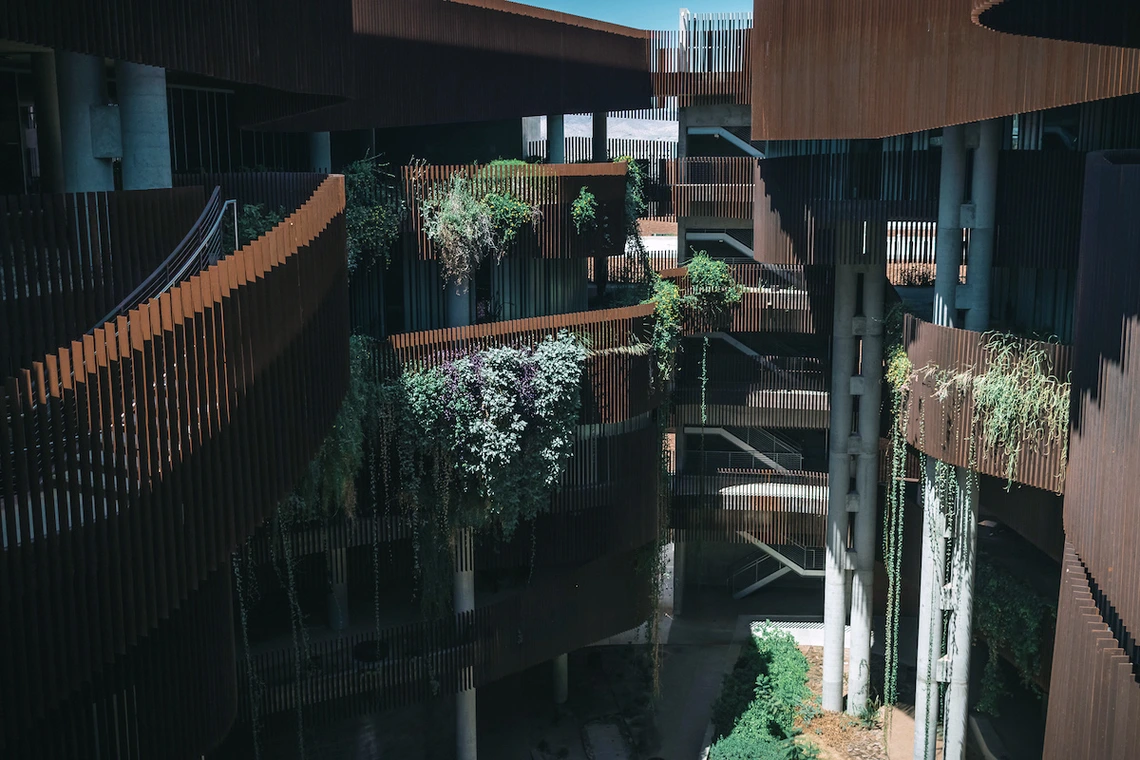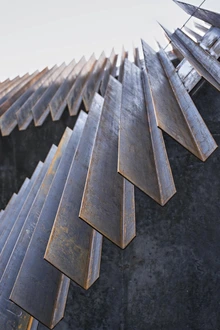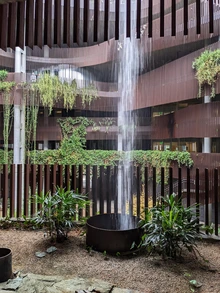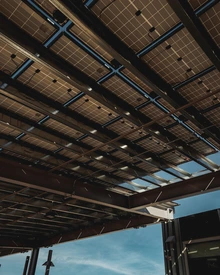ENR2 turns 10: The U of A's model of sustainability marks a milestone

Built with overhanging balconies, open-air walkways and wrapped in shading fins, ENR2 is designed to help regulate temperature while reinforcing a sense of connection to the natural environment.
Office of Sustainability
The Environmental and Natural Resources 2 Building on the Tucson campus, a showcase of the university's commitment to sustainability, is celebrating its 10th anniversary – and members of the campus community are invited to attend a special event in honor of the milestone on Sept. 10.
The Birthday Bash event will celebrate the building's award-winning, climate-conscious design and the learning and innovation that ENR2 fosters, said Trevor Ledbetter, senior director of the Office of Sustainability.

Trevor Ledbetter
"It's more than just a physical space," Ledbetter said. "ENR2 is a symbol of sustainability and community where students, faculty and staff come together to learn about, collaborate on and research solutions for our future."
ENR2 opened in 2015 following a decade of planning and design that began in 2003, with construction beginning in 2013. The process brought architects, engineers and other experts from throughout the university together to create a national model for sustainable design.
Building a sense of place
From the start, ENR2 was intended to be more than a building that housed classrooms and offices – it was designed as a model for a new way to build in the arid Southwest. ENR2's canyon-like appearance mirrors the desert landscape, with features that intentionally rust to tint its concrete surfaces, mimicking the patina of desert rock walls and creating welcoming spaces that leave an impression on many who enter.

Low-maintenance, durable building materials include unfinished metal "fins" that provide shade to the building.
May Carr, who has since retired from the university, was senior architect with Planning, Design and Construction and the building's design manager. The design team included Tucson-based GLHN Architects & Engineers and Richard+Bauer Architecture, the Phoenix firm that also designed the university's Bryant Bannister Tree-Ring Building and the award-winning Meinel Optical Sciences expansion.
"I appreciate how ENR2 provides space for shared experiences," said Ursula Basinger, Find Your Environment major exploration advisor in the Arizona Institute for Resilience, or AIR. "It's always refreshing to see the first impression the building makes on students. Their awe of the building can be used as an entry point to conversations about sustainability, nature, design and environmental topics."
Built with overhanging balconies, open-air walkways and wrapped in shading fins, ENR2 provides a cool refuge from a hot day. The building's living terraces, draped in vines and desert plants, help regulate temperature while reinforcing a sense of connection to the natural environment.
"My favorite thing about ENR2 is walking into work each morning and seeing the sunshine in the canyon lighting up the flowers and hanging vines," said Olivia Miltner, Arizona Environment Program coordinator with AIR. "I think ENR2 encourages us all to appreciate the small moments of beauty every day and remember how interconnected we are with the natural world."

ENR2's rainwater harvesting system fills the building's exterior corridors with waterfalls that lead to the cistern below, and watering the building's vegetation along the way.
Office of Sustainability
Laurel Bellante, director of undergraduate studies in the School of Geography, Development and Environment, agrees that it's a special way to start each day. "It's a privilege to work in such a beautiful and thoughtfully designed space. Each morning, walking through the courtyard and ascending the central staircase, surrounded by hanging vines, birdsong and a soft breeze, feels like hiking through a serene slot canyon."
Sustainability features
Feeling serene when entering ENR2 isn't something that happens by chance. ENR2 was built with an intent that incorporates sustainability features into the experience of being within the building.
While some features are hidden, like the 52,000-gallon cistern underneath the building, the rainwater harvesting system – which comes to life during a storm – is on full display, filling the building's exterior corridors with waterfalls that lead to the cistern below, and watering the building's vegetation along the way. This, along with low-flow installations throughout the building, helps ENR2 use nearly 40% less water annually than other buildings. It's one of the many sustainable features that reinforces the building's connection to nature.
"The psychological benefits of nature and green space are real, and the intentional design and execution of this building contribute to wellness, creativity and collaboration," said Kevin Bonine, director of education initiatives in AIR. "Not only is the building resource-efficient, but it has purposeful, yet beautiful, components that translate into more physical movement by the building's occupants and more interpersonal, social interactions."

The building's roof features 276 solar panels that produce about 15% of ENR2's annual electric needs.
Office of Sustainability
From the start, the more than 150,000-square-foot building was designed to serve as a home for world-class research and a living laboratory. Design features include a chilled-beam air conditioning system that circulates air throughout the building, vacancy and temperature sensors to control lights and cooling in individual offices, and rooftop gardens that absorb heat, offer insulation and provide a mini-ecosystem for birds, insects and plants.
"It's bustling with students, faculty and staff," said Stefano Bloch, associate professor in the School of Geography, Development and Environment. "But if you stop and pay attention, there are lizards in the bushes, pigeons on the exterior walkways, the occasional hawk in the air."
The roof also features 276 solar panels that produce about 15% of the building's annual electric needs.
Celebrating a decade
ENR2 is built to last 100 years. To join the celebration of its first 10 register online for the Sept. 10 Birthday Bash. The event is 1-7:30 p.m. and includes a resource fair, a Sonoran Desert biodiversity interactive exhibit with live reptiles, a building tour, reception and more.

